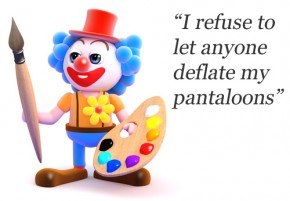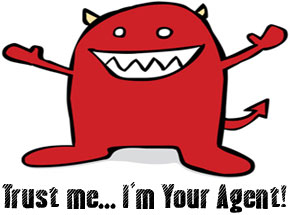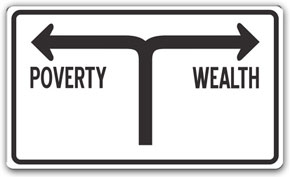As an Artist, you are a hunter. You didn’t know it, but you are. You are hunting elusive and rare game called the ‘Art Collector’. Mostly solitary creatures, roaming the plains of the art gallery establishment they need very tasty bait if you want them to come out of hiding, cheque books in hand. If you actually manage to figure out how to sell art and snag enough of these collectors with your tasty wares then there is the potential for more of them to head your way, demanding all the morsels you can feed them. But, as an artist, do you have enough fresh carcasses in the cupboard?
What do collectors want?
Okay, enough already with the selling fine art safari adventure. Lets leave the Land Rover and gun behind and check out of the Treetops African resort to examine what it is that art collectors really want from an artist and their artwork.
Most people who buying art are not art collectors. They are just people who like to decorate their homes with nice things. If you and your art have a good name and that certain je ne sais quois then these home decorators will buy your art, maybe even lots of it. There is money to be made there.
Real Art Collectors on the other hand (of the serious variety) are also ‘art investors’ to varying degrees, and when I say ‘investor’ that can mean not just in terms of money. Art Collectors want much much more than a pretty picture when they are considering buying your art, but of course they may also be in the business of selling fine art themselves (ie buying your art with a view to selling your art in the future when your stardom climbs to the stratosphere).
My own art has been mostly been bought by home decorators; the people who just love it because its a beautiful thing to behold, and it makes them happy when they see it in their homes. I have though on occasion had my art purchased by the real deal collectors that artists dream about having on their exhibition mailing lists. I once delivered one of my paintings to a client who had a collection in his multi-squillion dollar home that almost made me weep with joy at seeing it (after all it’s not everyday you see a Gauguin hanging in someone’s living room.) I wish I had more clients like that, but he is the exception rather than the rule in my customer Rolodex.
So what do these elusive collectors want from us?
So what do they want from us artists when we are selling fine art, these elusive collectors?
You are selling Fine Art… not cheap art
First of all they do not want cheap art. They like expensive art. Very expensive art, and very rarely do they descend to the sub $3000 level (or thereabouts). Sub $3000 for a real collector is bargain basement art made by a bunch of unknowns, and there is bucket loads of competition in the ‘unknown artist’ marketplace. Sure, they might pick up a few trinkets under that level for fun very occasionally but mostly they themselves are hunters of next big thing and big name artists.
Why is the art they buy expensive? Well, it tends to have a track record. We’re not just talking here about a few first prize rosettes at the local show, or a few facebook ‘likes’ on your free artist website; we’re talking major recognition for an artists achievements by the tastemakers and tastebreakers of the art industry, possibly selling fine art over an extended period, so that the prices for works by that artist have been well established and are preferably heading upwards. Art collectors who like to live on the art investing side of town do not like to gamble; they like to really invest in beautiful things, for some kind of gain later (whether that be through status of ownership, preservation of ‘culture’ or financial gain).
Most serious artists who the real collectors chase do a major amount of work to get to where they are. Often they study, travel, sometimes choose to live in extreme circumstances, they mix with other about to be famous artists in ‘a school’ and they pull off major exhibitions in serious galleries of both the commercial and culturally important kind. They don’t tend to paint nice landscapes on a Sunday for delivery to the local gallery on Monday. They live full and colourful lives. They are interesting, intriguing and their legend grows as their dealers, friends and hanger-onners spread the word of their artistic exploits throughout the land. In short, they are dedicated to selling fine art to the art world in a serious way (and their dealers really know how to sell art too).
Real art collectors love a good story. They love a track record. They love an established price that has been set in sales in both the primary market (Galleries) and the secondary market (auction houses). They love to hob-nob with the best Art Gallery Directors who give them the priority inside track on what’s really going down in the art world, and they like their artists to be elusive in a manner which befits their superstar artist status (even though they might aspire to actually meet them one day).
This can be frustrating for the sub $3000 artists. We actually want to engage with our clients, we are willing to meet with them, we want them to love us and we want them to love our art. Surely art collectors will buy our art if only we can reach out to them, won’t they?
No. They won’t.
What they will do if they are really interested in you is watch and wait. They will keep an eye out for you in the galleries (who are really selling fine art – not local tourist galleries) and the magazines, they will quietly pop by to see how your exhibitions are doing. They will hold you on mental file until such time that you prove you and your art are a worthy investment either culturally or financially, and then as your star begins to ascend into the stratosphere and you are actually selling fine art (in quantity) they will begin to pick up some of your work.
By this time of course you are on the way to being a successful artist and are starting to be a little bit elusive yourself (in the manner of the real superstar artists), not because of some tendency towards being a hermit, but because you are in actual fact so busy painting to supply the collector public who are buying art that you create. Short supply sends the prices on a skyward trajectory. The collectors like that too.
So what do collectors really want?
They want you to be a serious career artist making serious art.
Are you?












This is a comment for your whole site in general. I have been struggling with my art for the past year especially with the failed economy of late. I’m always searching the internet for direction. Well I finally found it in you my friend. You pretty much hit on all the subjects that I’m dealing with.
Thanks for the inspiration!
Scott
After reading your article it brings up a question for me – is the work of an artist diminished to the “art investors” if some of the work is priced for the “art collectors”?
Thank you for the words of wisdom. Wood art rocks.
Michael L.R.
I was searching for a sufficient answer, and I got one. I live in Arizona and I go to the art walks in Scottsdale. I’ve met the professionals and legends there. Not always impressed by their work, but always noticing collectors huddling around the artists. Which sucks for me at times, because even though I’m a digital artist, I like to get tips on what paints the artist used and so on, but I get shoved off because I’m not a buyer. Or sometimes ignored by an artist..how rude…lol!
They probably dont want to talk shop while they are in the middle of a sale 😉 Thats wise!
I had a show at a pop up gallery in Scottsdale, and it was so dead I would have welcomed anyone who wanted to talk to me!
I’ve been at painting for a long time and find your article refreshing and confirming. For myself the underlying message is “hard at work” is better than “working harder” to achieve your results. With this of course is the art of finding patience also comes to mind as well. Thank you for your insight.
Thanks for the kick in the butt! Josph Raffaael gave a presentation at my art school back in 1980 something. He asked us if we wished to be successful artist and wanted to know how to do it. Of course we all did and his response was “well then you just have to do it!” It takes a lot of hard work to be successful at anything!
a great down to earth informative article, thanks for the guidance, hard work with persistence and perseverance I guess.
Thanks for this article! Very useful. Loved it!
Dear Sir/Madam,
My oil paintings are mixed of realism and impressionism styles . I am graduated fine art and tourism from Azad university of Tehran .I had some exhibitions in Armenia and Iran . Since I am suffering from bone cancer for one year , I have left my tourism job and continue painting . I have decided to sell some of my canvas which makes me very happy in this difficult situation .Just I wanted to check if you buy these kind of oil paintings ? of course I have to mention my sisters live in Los Angles and I don’t have any problem regarding sanctions difficulties . If interested I can send you some of my original oil paintings with my signature.
Thank you again
Verjineh Eskandari
I feel kind of sad for people who buy art with an eye to selling it off when it is worth more money. I love art and feel lucky to have some small originals, I would never resell because they are meaningful to me. Most of my sales have been to friends and art lovers. I did sell a few paintings to a collector in a million dollar home but I got the sense she absolutely loved art and her collection was interesting to see. I’m not sure I would even want to sell to someone who was just investing. I’m also pretty sure that isn’t going to happen in my lifetime…I would be curious though to find out. Haha! Happy art making!
Where I live there is very little art and many who call themselves artists. Those who call themselves patrons of the arts being mesmerized by trinkets caught-up within galleries.
I was selling well, but the gallery took 40% of what I made, so I had to raise money on my art work, and I thought it was unfair to the buyer. I decided to withdraw my art from the gallery even-though my name was on the rising and I was selling.
Now I have a quilting long-arm machine and I quilt original quilts and sell on my own. I love anything I can work with my hands. I’m the one who sets the $ value. It’s not all about prestige and bottom dollar. At the end of the day, can you make a decent living and mostly loving to work at your art? Often sacrifices in life provide value and appreciation. This is how I approach making a beautiful painting or quilt. All comes from within me and not to satisfy a group of people.
I think art collectors esteem high quality art and a unique style. They also are intrigued by artists who have a interesting story behind their life, approach to work and a unique viewpoint.
Having spent my life in various artist professions I believe the success I have achieved in my artistic career has been my passionate desire to always deliver a quality product and to always keep learning new things. This is how you build a reputation. Quality shows. Take the time to make it the best work that you can possibly deliver. Only show your best work. Don’t create art that doesn’t excite you. It will show. Put your heart into the piece. Paint what excites you. If you love the work, chances are someone else will love it also. Don’t try to paint like someone else. Be yourself, refine your skills, never give up and always keep trying. Believe in your God-given talent and always keep learning. Never give up. Do what you love and the money will follow.
You make a good point that most people that are buying art are simply people that want to decorate their homes with nice things. I can imagine that for an artist, It is people like that that are where a lot of their income comes from. I would love to support artists in this way by buying their pieces!